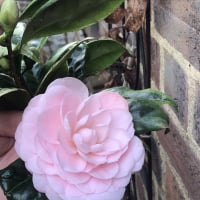This Forum will close on Wednesday 27 March, 2024. Please refer to the announcement on the Discussions page for further detail.
Dahlias vs slugs. Actually just slugs.
 Camelliad
Posts: 402
Camelliad
Posts: 402
It seems to me that there are two camps amongst those with beautiful dahlias with intact leaves (envy emoticon). The camp that uses the blue pellets and the camp that goes out on midnight patrol with a head torch. I start the day with the best of intentions but by the evening I'm in the "let the dahlia fend for itself, I'm on the sofa" camp. But also I'm not sure what I'd do with the slugs if I caught them. I can't snip them - ew, I can't drown them - ugh, I like my neighbours so I don't want to throw them over the fence. If the garden birds and hedgehogs could form an orderly queue...
I love dahlias, but I don't have the energy to look after them. Is that wrong? Should I be looking at this another way? I used nemotodes and all the water. I'm currently using garlic spray. I have some in pots at the top of a ladder and they're doing fine. Should I pot them up and grow them on until they're a certain size? Do the slugs leave them alone once they reach a certain size?
I'm wondering also if I have super slugs. They ate my salvia. I thought salvias were slug proof. Definitely slugs though. There was a trail.
I love dahlias, but I don't have the energy to look after them. Is that wrong? Should I be looking at this another way? I used nemotodes and all the water. I'm currently using garlic spray. I have some in pots at the top of a ladder and they're doing fine. Should I pot them up and grow them on until they're a certain size? Do the slugs leave them alone once they reach a certain size?
I'm wondering also if I have super slugs. They ate my salvia. I thought salvias were slug proof. Definitely slugs though. There was a trail.
0
Posts
We have a good variety of slugs in the wildlife garden, but never too many of the most damaging small grey and white ones. I grow lettuce with total impunity to slug attack, any daft enough to venture on to the veg plot, there are eyes on them.
There really is a lot of sense in developing a 'diversity area', 'wildlife garden', 'messy bit', call it what you want in a garden, not having cats, but instead putting in habitat such as ponds, log piles, overgrown areas to support native wildlife.
It's an imbalance in gardens that causes the slug problems in the first place, I've never once found a site working for years as an ecologist that had a 'slug or snail problem' in the wild.
Someone told me that the darker leaved dahlias succumb less easily but mine are still munched.
Battling slugs without them is just a battle nobody ever wins in my opinion, be it nematodes or pellets, the problem does not go away, it just remains year on year.
Using artificial control also discourages the very predators that would control them for you, by removing their food source before they establish large enough populations to control them.
Hope it is food for thought, your OH was always right about that pond, get digging for the dahlias
One more question @GemmaJF and @micearguers - with all the wildlife in your garden are you extra careful with the lawnmower? Or does the grass never get so long that you can't see what's in it? When we first moved in it was completely overgrown and I made my OH walk up and down the garden with a stick first to make disturb the grass before he mowed. I don't think he's ever forgiven me for that...
Slow worms can be locally very abundant, but their distribution these days is very 'patchy' If your neighbour has them, your in luck!
The secret to reptiles in our garden, which I'm more than happy to share is a 'hibernation bund'
When I dug out the pond, I placed a lot of hardcore down and covered it with the soil I dug out. This forms an 'underground' system of caverns ideal for reptiles and amphibians to hibernate in. I then built extensive log and brash piles on top of the bund. South or west facing in the sun is good for reptiles, as in the spring they can bask and warm up easily.
I've always thought reptiles are a good 'indicator' species, so what works for them also works for a lot of insects, small mammals and birds, so the bund is a busy place for wildlife these days.
Slow worms love compost heaps too, I have several, cold heaps, hot heaps, they move around them as they choose.
I also put down corrugated tins or felts. They love to warm up under them. They are super elusive, even though one can have plenty in a garden, so looking under tins or felts is often when I see them. On the right days, often in large numbers.
I'm really getting to the point now where I really only have mown paths, even the front lawn is being eyed up as a no-dig veg plot, with wildlife friendly features.
I try to do everything to benefit the wildlife in some way. We are about to put in a patio, I looked at concrete mixes and it being a fully hard area, then found out I could simply put the stones on sand. Slow worms can burrow in sand.. so more habitat for them and a nice new area for pot plants for me.
Can you encircle them with something to protect them when they're young?
I grow all mine in pots so don't have any issues.